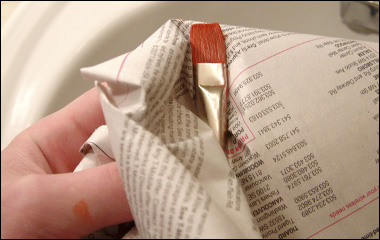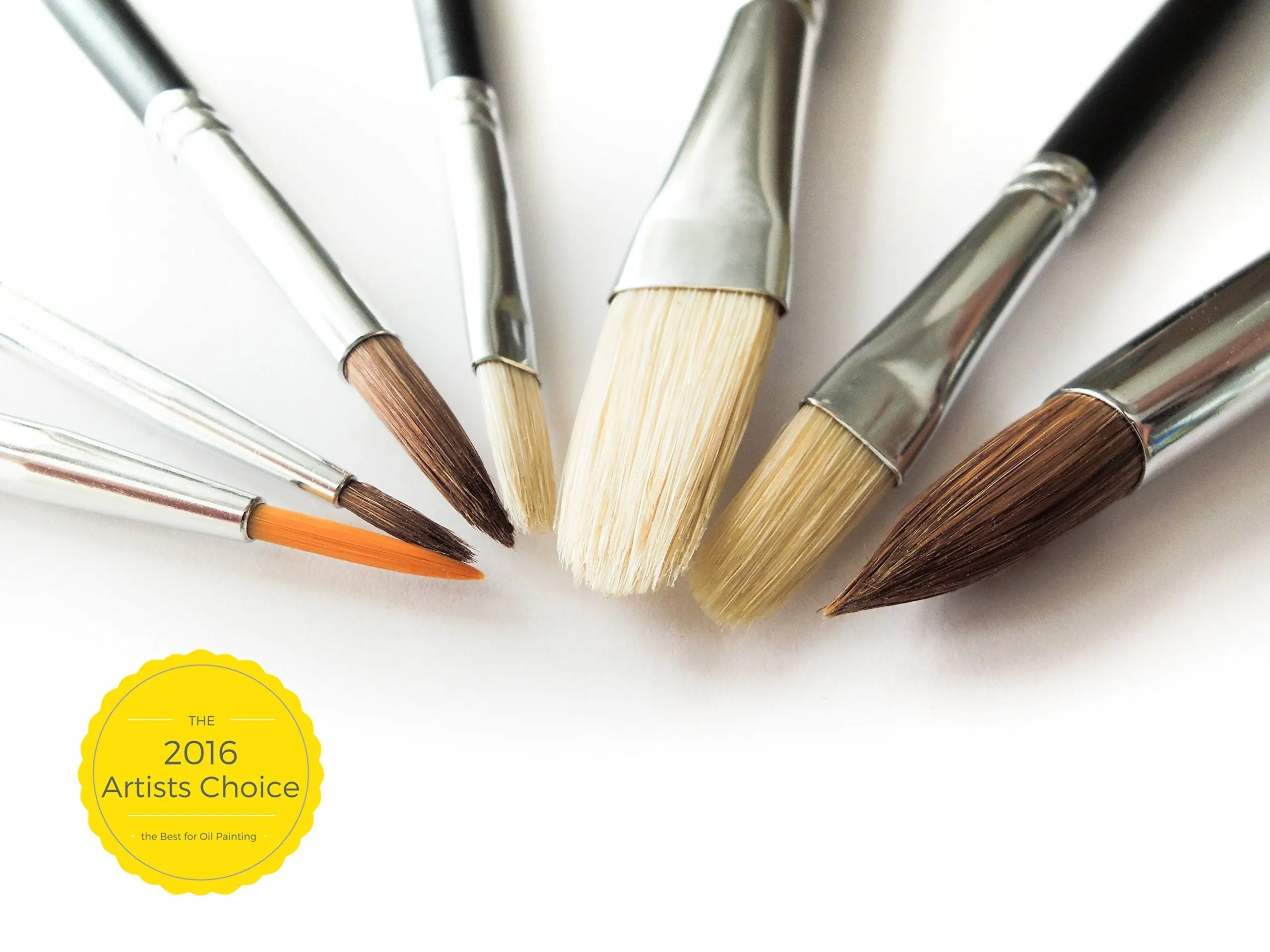There are good options for naturally cleaning paintbrushes — including those used with latex and chalk paints and those used with oil-based paints, stains, and varnishes.
- Wipe the excess paint (or varnish or stain) off your brush with a clean cloth or paper. Place some oil in a shallow pan. Options that are safe for you and the environment include linseed oil (also called flaxseed oil, an ingredient in many paints, varnishes, and stains), baby oil, or another natural oil, such as sunflower oil.
- Avoid letting paint dry in a brush. The paint will dry in the heel of the brush near the ferrule, making it difficult to be removed. This will cause the brush to lose its shape, brush hairs will fan out, and eventually, the brush will be unable to be used. Do not use lacquer thinner, shellac remover or acetone to clean brushes.

I do a lot of painting. No, not landscapes and still lifes. (I wish!) I’m talking household refreshing. Right now, my paint to-do list includes: porch railing, house foundation, television armoire, indoor steps, and various spots on the walls (casualty of moving curtain rods up). I’ll be using all kinds of paints and all kinds of brushes. Luckily, I like to paint. It’s such a (relatively) easy and (relatively) inexpensive way to completely freshen up a room or piece of furniture.
What I don’t like is clean up. Especially the brushes. I’m often tempted to toss a paintbrush after a project is completed. But I don’t, of course. Oh, I once justified tossing a brush after reading that the amount of water it takes to clean a brush is environmentally more damaging than tossing the brush and buying a new one. If you use a more thoughtful cleaning method, though, that needn’t be the case (if it ever was).
Be careful not to kick up the oil-based paint settled in the bottoms of the bucket and pan. Swing the brushes and rollers gently side to side to remove excess paint thinner. Set the brushes and rollers on the newspaper and dab them with paper towels to remove excess liquids. Allow them to air dry.
Admittedly, oil-based paints are harder to remove than latex or chalk paints. Most people use solvents like turpentine and other paint thinners to remove oil-based ingredients. But those ingredients are toxic for you and for the environment. And that’s the main reason I use latex or chalk paints most of the time.

Occasionally, though, I’m convinced that an oil-based paint will do a better job (last longer, look better), or I use another oil-based product, like a stain or varnish. That’s when I’ve really been tempted to toss the brush when the project was done. No more. With a little care and patience (really, it doesn’t take much longer!), we can clean our brushes without using toxic paint thinners.
All you need for naturally cleaning paintbrushes is some dish soap, clean rags, and — for oil-based paints — some oil. Here’s what to do:
For brushes used with latex and chalk-based paints

- Swirl some warm water and a little mild dish soap or baby shampoo in a container. Don’t use too much soap, especially with natural bristles, or you’ll damage the bristles. I suggest about a teaspoon per half gallon of water. Non-foaming soap works best.
- Wipe excess paint off the brush with a cloth.
- Swirl the brush around in the water for a few minutes.
- Wipe with a clean cloth.
- Repeat until most of the paint is removed.
- Rinse under running water, using your fingers to remove any remaining pieces of paint. Make sure to get the handle and ferrule (where the bristles are bound to the handle) clean. The ferrule can hold paint, which will deteriorate the brush.
- Blot the brush dry with a clean cloth or towel. Or spin it in the air. (I recommend you do this outside — it will splatter.)
- Hang the brush with the bristles down (so the water doesn’t drip into the ferrule) or lay it flat to dry.
For brushes used with oil-based paints
Ever tried to clean brushes covered in oil-based paint using water and soap? The water just rolls off, right? Kinda like when you’re trying to mix oil and water for a vinaigrette! That’s when we reach for the heavy duty solvents. But wait! Some natural oils will also do the trick.
Let’s start with a little background info for those who are skeptical and reluctant to let go of their solvents/paint thinners. Paint thinners work by thinning the paint. Here’s what that means: oil-based paints are made of oil (often linseed oil) and color pigments. Adding a solvent like turpentine or mineral spirits dissolves the binding agent and separates the pigment from the oil. Here’s another, natural method for doing the same thing:
- Wipe the excess paint (or varnish or stain) off your brush with a clean cloth or paper.
- Place some oil in a shallow pan. Options that are safe for you and the environment include linseed oil (also called flaxseed oil, an ingredient in many paints, varnishes, and stains), baby oil, or another natural oil, such as sunflower oil.
- Dip one side of the brush into the oil. Turn it over and dip the other side into the oil.
- Work the oil into all of the brushes. (Your fingers work best for this job. Put on some rubber gloves, if you like.)
- Now you can pick between two options. Either use the brush to paint on a piece of paper, back and forth (make X’s), or take a clean cloth and wipe out the oil and paint.
- Repeat steps 3 through 5 until most of the paint is removed.
- Swirl some warm water and (a little) mild dish soap or baby shampoo in a container. (While soap and water aren’t enough on their own to remove the paint from the get-go, the surfactant in soap lowers the surface tension of the water and helps dissolve compounds. So it’s great at finishing up the job.)
- Dip the brush in the soapy water and swish around for a couple of minutes.
- Rinse under running water, using your fingers to remove remaining pieces of paint. Make sure to get the handle and ferrule clean.
- Blot the brush dry with a cloth or towel. Or spin it in the air (outside).
- Hang the brush with the bristles down (so the water doesn’t drip into the ferrule) or lay it flat to dry.
To soften a hard brush
Check your paintbrushes. Do you have any that have hardened? That usually means the paint hasn’t been thoroughly cleaned out of the bristles. Before tossing the brushes, try this method for softening them up:
- Place the brush in a container. (Try to prop it so that the weight isn’t straight down on the bristles, which might bend them.)
- Pour boiling vinegar over the brush. Let the brush sit in the hot vinegar for about ten minutes.
- Wipe or scrape off any paint reside with a cloth or a brush comb. Don’t use a metal or wire brush or you might damage the bristles (by making them curl).
- Repeat if needed.
- Wash the brush as directed above.
- Blot dry with a clean cloth or towel. (Or spin it in the air, outside.)
- Hang with the bristles down, or lay flat to dry.
General tips
• Prep your brush before using it, especially the first time. This gets any stray bristles out of the brush (so they won’t wind up in your painted surface. Don’t you hate that?) Simply hold the brush firmly and give it a soft whack on a hard surface a couple of times. Then rinse the brush and remove any loose bristles. Pat dry. (It’s fine to start painting latex with a damp (not soaking wet), brush. In fact, it might even make cleanup easier.)

• Clean your brush as soon as you’re finished using it. If I’m going to use mine again very shortly (after a cookie break, for example), I wrap it in plastic, and it’s perfectly good to go when I get back to my project. But experts caution that leaving paint on a brush for any length of time can irreparably damage the bristles. So don’t wrap it in plastic overnight; take the time to clean the brush so you’ll both be fresh the next day.
• Be careful with the bristles. If you want a smooth and even paint job, you need bristles that aren’t bent, splayed, or frayed. Keep this in mind when cleaning your brush (don’t use too much elbow grease!).

• Don’t stand brushes up in water or cleaning solutions or you’ll bend the bristles. Hold them by the handle and dip them.
• Don’t soak brushes in water past the base of the handle. The glue holding the bristles in the ferrule can loosen, and you’ll wind up with stray bristles in your painted surface.
• Reserve one set of brushes for use with latex paints and another for oil-based paints, varnishes, lacquers, and shellacs.
• If you have a synthetic brush that’s out of shape, try steaming it to reshape it.
• When painting, only dip your paintbrush into the paint about a third of the way up the bristles, to prevent getting paint in the ferrule.
• Don’t use rubbing alcohol on your brushes. It’s too drying and can damage the bristles.
Following these tips and using these cleaning methods means that I always have a nice selection of brushes available for my painting projects —without having to keep toxic solvents on hand. Do you have any solutions for naturally cleaning paintbrushes? Please share!
How To Clean Oil Based Paint Brushes With Vinegar
You might also like: Shine on! How to take good care of and refurbish stainless steel flatware and Brooms — How to clean and care for your household broom.
